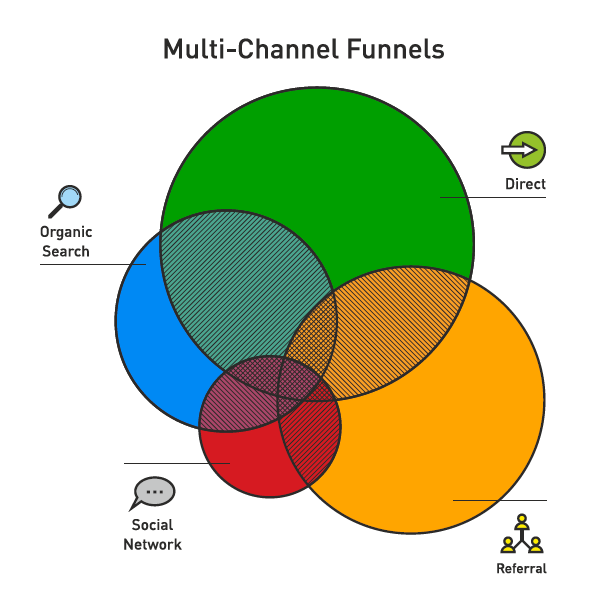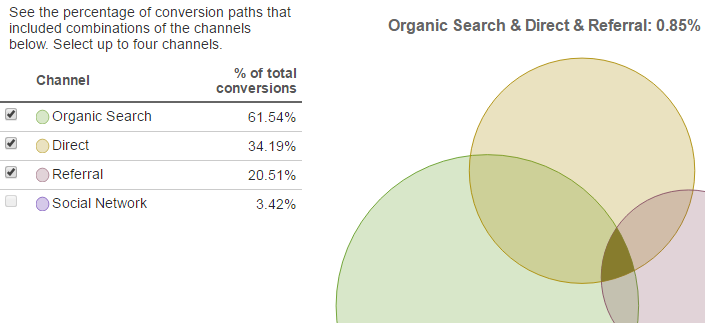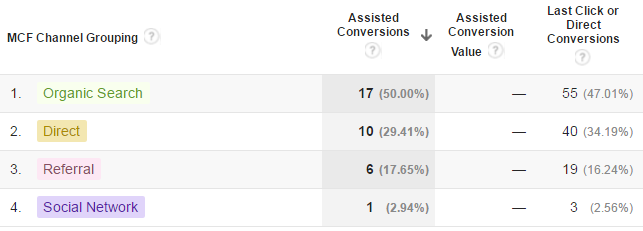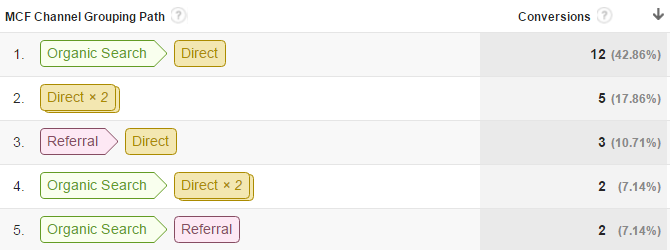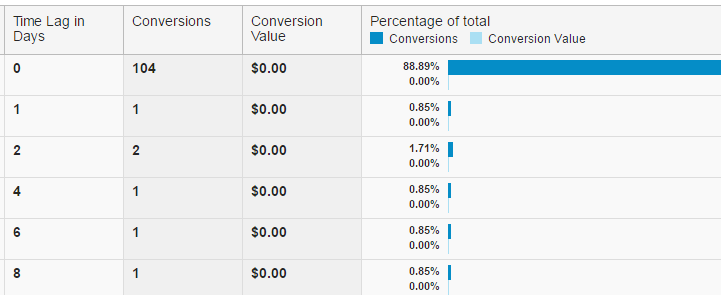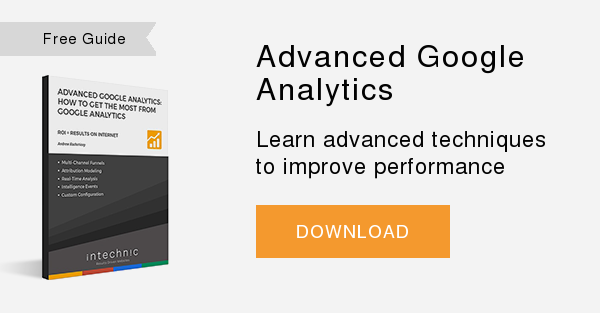Google Analytics Multi-Channel Funnel and Attribution Modeling
 The Google Analytics Multi-Channel Funnels reports are perhaps the most under-utilized tools of Google Analytics, yet they are some of the most powerful. The reason most people don't even look at these reports is because they lack the basic understanding of the value of this data. Here's how to make the most of them.
The Google Analytics Multi-Channel Funnels reports are perhaps the most under-utilized tools of Google Analytics, yet they are some of the most powerful. The reason most people don't even look at these reports is because they lack the basic understanding of the value of this data. Here's how to make the most of them.
Google Analytics Multi-Channel Funnels
What is a multi-channel funnel? In many Google Analytics reports, goal conversions are credited to the last source (channel) that brought the visitor to the website. But, how can you tell if other websites and social media referrals search or ads play in that conversion? Multi-Channel Funnels show how all channels of traffic to the website work in harmony to convert your visitors to customers.
Overview
The Overview report gives a bird's-eye view of conversions and assisted conversions (those associated with more than one channel) and allows you to select a maximum of four channels to visualize the overlap between them (where one, two, three or all four channels played a role). Note: In this report and all other Multi-Channel Funnels reports, you can adjust the Look Back Window (a period of between 1 and 90 days prior to each conversion).
Assisted Conversions
An assist for a conversion is a channel (a source or a medium) that appears anywhere on a conversion path (except the final interaction). For example, let's say that a visitor originally found your website in Google (Organic Search), then saw a mention on Facebook (Social), then bookmarked your website and returned through the bookmark (Direct) to convert. In this case, both Facebook and Google assisted in the conversion. Using the example above, the Assisted Conversions report shows the contribution of each channel in the conversion: Last Click ("Direct" in the example) is the number of conversions and revenue the channel closed (i.e., the final interaction). First Click ("Organic Search" in the example) is the number of conversions and revenue that the channel initiated (i.e., the first interaction). Assisted/Last Click or Direct Conversions summarizes each channel’s overall role in conversions: a value close to zero means that the channel produced more conversions than assists; where a value close to one means that the channel generated more assists than direct conversions.
Top Conversion Paths
This report shows the most common Multi-Channel Funnels (MCF) paths visitors took toward the goal. For example, if your top-performing MCF is "Organic Search > Direct," this means that most users find your website in search engines, bookmark it and then return to the website to convert. You can change the dimension in this report to source/medium, source, path and others to have a good picture of the various routes your users take to return and convert on your website.
Time Lag
This report gives you the number of days it takes visitors to convert. You can see the breakdown by the number of days that occur between the first visit and the conversion. By doing so, you will learn a great deal about the sales cycle of your website.
Path Length
This report shows the number of interactions (between 1 and 12+) it took visitors to become customers.
Multi-Chanel Attribution Modeling
Of all Analytics reports, multi-channel attribution models are probably the most complex. They require a very deep understanding of your business model and how different channels work in harmony to generate conversions. It requires scrupulous and precise set-up, so be prepared to spend sufficient time learning to the full use of this tool. Otherwise, avoid it completely. Hasty decisions made on reports that are improperly configured or analyzed can send you in the wrong direction. So what is attribution modeling? It is the process of understanding each channel's involvement in conversion and assigning the proper credit for its contribution to the conversion. With the help of Multi-Channel Funnels, we've already learned that there are multiple channels contributing to conversions, but are they equal in their contribution? Not quite. As every business is different, and every business' sales cycle is different, attribution modeling helps you understand the buying behaviors of your website visitors as they apply to your scenario. This helps determine the most effective marketing channels for your marketing dollars. Google Analytics is equipped with several baseline attribution models that define how credit is distributed to interactions in a conversion path. There is no model that fits a business’ needs exactly, so the best model depends on your specific business and your advertising objectives:
Last Interaction
This model assigns 100% credit to the last interaction. It is useful in campaigns that are designed to attract visitors at the decision stage and for sales cycles that have little or no consideration phase. This model is also referred to as Last Touch and is great for fast-moving consumer goods.

Last Non-Direct Click
This model ignores direct visits and assigns 100% credit to the last channel. Google Analytics applies this model by default to Multi-Channel Funnels. It is also used for other reports, so this model is a good benchmark. If your traffic shows that visits from other channels always preceded direct visits, this model will filter out direct visits.

First Interaction
This model, also known as First Touch, assigns 100% credit to the first channel with which the user interacted. It is useful for campaigns that are designed to create initial awareness of a brand and attract customers who were not previously exposed to it. If you are a new player in your niche market, and your brand is not known, this may be a good model.

Linear
This model gives equal credit to each interaction in a conversion path. It is particularly useful if your campaigns are designed to maintain constant contact with the customers and if all touch points in your sales cycle are equally important. An example is a customer support oriented service.

Time Decay
This model assigns more credit to the interactions that occurred closest to the time of conversion. The time decay model is useful for short promotional campaigns (one or two days); where you want to give more credit to interactions that occur during the promotion.

Position Based
This model factors in the order of interactions and assigns 40% credit to the first interaction, 20% credit to the next interaction and 40% credit to the last interaction. It is useful for campaigns that have initial touch points to introduce the customer to the brand and final touch points that result in sales.

Last AdWords Click
This model use this model if you advertise through Google AdWords. This model will assign 100% credit for conversions to the last Google AdWords click in a conversion path.

Custom Models
This model you can also edit attribution models or even create your own by selecting a baseline model and tweaking parameters.

After you select the model or models that are a good fit for your business, it is important to understand the metrics they illustrate:
- CPA - Cost Per Acquisition shows the cost to generate a single conversion (on average) under a particular model.
- ROAS - Return On Advertising Spend is calculated by dividing the conversion value (total sold) by the total dollar amount spent on a particular channel.
By selecting an appropriate attribution model, you can see the performance and the ROI on each of the channels. Note: you may have to upload your non-Google cost data sets (for example, if advertising is purchased in search engines other than Google) so the cost information is available in the Google Analytics reports. Ask your web developer for assistance with this step. Interested in learning more about using the advanced features of Google Analytics? Check out the next blog post, How to Get the Most from Google Analytics – Tips, Tricks & Best Practices, or download our free guide below:


